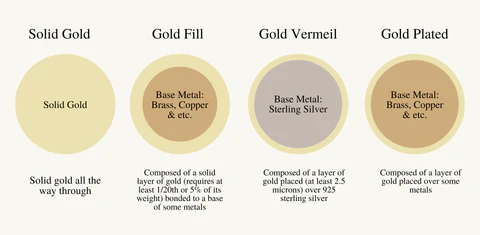
Introduction
Gold, a symbol of wealth for centuries, has different types. Each type has unique benefits and drawbacks. This blog post explores four main gold types: rolled gold, plated gold, filled gold, and vermeil gold. We’ll also discuss British hallmarks, crucial for determining gold purity.
Gold Types
Gold’s value remains high, but not all gold is equal. Different gold types have varying quality, durability, and value. Let’s explore rolled gold, plated gold, filled gold, and vermeil gold.
Rolled Gold
Rolled gold, a jewelry type, consists of a base metal, usually brass, covered with a gold layer. The two metals bond when heated together. The resulting material, rolled into thin sheets, is used to make jewelry. The gold layer in rolled gold is typically around 2.5 microns.
Rolled gold is more durable than other plated jewelry types. Its gold layer is thicker, so it lasts longer without tarnishing. However, it’s more expensive due to its high quality.
Plated Gold
Plated gold bonds a real gold layer onto another metal. It’s less expensive than other real-gold jewelry types since it contains less actual gold. However, the real gold layer can wear off over time. The gold layer in gold-plated items is usually less than 0.5 microns.
Filled Gold
Filled gold is created by pressure bonding a layer of gold to another metal. This creates a thick layer, usually 5% of the item’s total weight, of real gold on the surface. The gold layer in gold-filled items is about 2.5 microns. Filled gold is more durable and tarnish-resistant than gold plated items. It’s a more affordable alternative to solid gold.
British Hallmarks
British hallmarks certify gold, silver, and platinum items’ quality and origin. They indicate the metal’s purity, the place, and the year it was assayed. Understanding British hallmarks helps consumers make informed purchases.
Cash for Gold
Cash for gold services offer individuals the chance to sell their unwanted gold items for cash. These services assess the value of your gold items and offer a price based on the current gold market rate. However, it’s important to note that items such as rolled gold, plated gold, and filled gold may not be suitable for selling to a cash for gold service due to the minimal amount of gold they contain, which is not worth refining.
J Blundells
J Blundells, a reputable UK gold dealer, has been providing quality services for over 100 years. They offer fair prices for gold and use state-of-the-art technology to accurately assess gold items’ value. J Blundells is willing to purchase rolled gold and filled gold in batches of more than 500 grams due to the higher refining costs and longer turnaround time of about 2 weeks.
Conclusion
Understanding different gold types is essential for gold investment or purchase. Rolled gold, plated gold, filled gold, and vermeil gold each have unique benefits and drawbacks. Knowledge about different gold types helps you make informed decisions.


